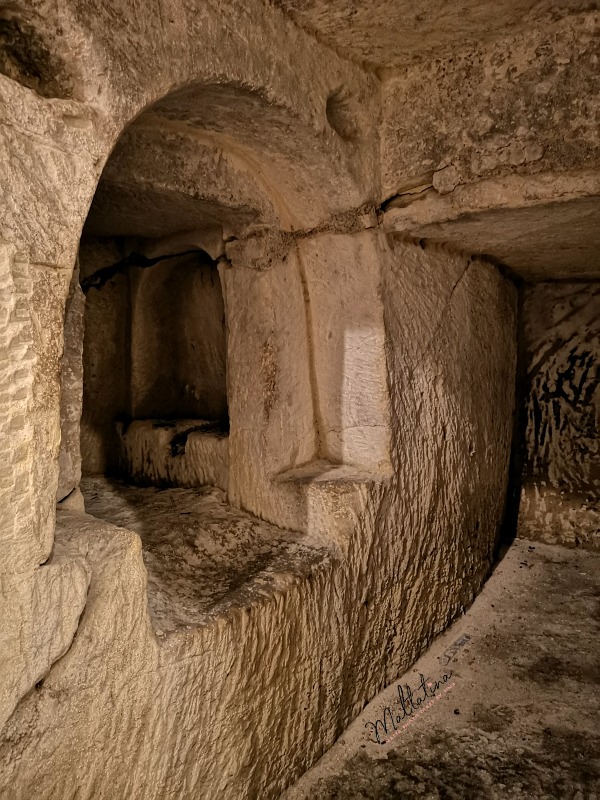Ta’ Bistra Catacombs, Mosta
At this time of year weather in Malta is rather unpredictable. Indoor activities are the safe option so here I am. This time I’m going to show you around and tell you more about Ta’ Bistra Catacombs in Mosta.
The access to the catacombs is via this small farmhouse. Doesn’t look like anything special from the outside, does it? Wait for it, I’m sure you’ll be pleasantly surprised.
The first known record of Ta’ Bistra Catacombs is an 1891 sketch by the scholar F. Vassallo. The site was repeatedly mentioned and photographed by number of pioneers of Maltese archeology, but was only investigated in 1933 by C. Zammit. Unfortunately very little information was revealed due to the fact that all the tombs had been looted and used for other purposes.

When you walk through the door, on your left side is the cash desk and on the right these two displays. The first one displays three lamps, which are a common artifact in tombs from the Phoenician Period up to the Roman/Byzantine Period. All three lamps were found onsite during the excavations works carried out in 2014.
The second display showcases a skull which was reputedly recovered in the area of Ta’ Bistra. As you can imagine, usually a large amount of bones are expected to be found in tombs. However, C. Zammit discovered very few bones during his excavations in 1933.

To see the actual catacombs you need to walk down two flights of stairs. There is a lift, but it wasn’t working when I visited (November 2019) so the security man kindly helped me with the pushchair down (and up) the stairs. If you need to use the lift for healthy reasons I would call in advance to check if the lift is functional.


The Catacombs consist of extensive system of early Christian tombs with individual entrances. We’re talking about sixteen groups of hypogea (underground vault, esp one used for burials) excavated next to each other. This catacomb complex is actually the largest complex to be discovered in Malta. Unfortunately it suffered extensive damage through re-use since it had been abandoned.
The farmhouse though which you entered was built in the mid-20th century and these burial chambers were used as storage areas and animal pens! The owner even started digging an air raid shelter, despite the fact that WWII had already ended, using the tomb groups as entrance.


The Catacomb Complex is kind of divided into three parts. The first part is located within the farmhouse premises. The second part is outdoor, part of which is roofed as you can see below. The third part of the complex was purposely covered to be protected from the elements.
The Catacombs in the first and second part are accessible and you can walk into each of them. All the tombs in the third part of the complex are behind a fence.


While entering the third part of the complex you can have a look at the detailed layout of the entire Catacomb network.
One can only find two types of tombs, which are the ‘window tomb’ and the ‘cubiculum with arcosilia’. The most common one is the window tomb, which is an oval burial chamber accessible though a square opening.
What’s also very interesting, is the lack of children’s tombs. The average life expectancy in Roman period was around 25 years of age. And only 3 out of 5 children were expected to live more than 12 months. Therefore the lack of child burials within Ta’ Bistra complex is very surprising. One of the explanations could be that they were buried together with adults.


The site was heavily affected by quarrying. If you look carefully, you can spot the tool marks in various places.
What you will also notice are rock bolts. They are drilled deeply into the ridge to protect the sliding action of the rocks boulders and preserve the site in its current state.


Here you can see a double headrest which originally served as a pillow for the bodies in a window tomb. It is different to the usual headrest due to an elevated bottle stand in between the two headrests.

In the above photo you can see a rock-hewn table ‘triclinia’ which was used for commemorative meals. They are very common in Maltese Catacombs. Two such tables were found at Ta’ Bistra, but this is the only one that has survived until today. It’s worthwhile to mention, that even though such tables were used throughout the Roman world, it is only in Malta that they were hewn out of the living rock!

Couple of tips before I finish off. The opening hours of Ta’ Bistra Catacombs are Tuesdays, Thursdays and Saturdays from 9:00 – 17:00 with the last admission at 16:30. However last Saturday I went in at 4pm thinking I still have an hour, but it turned out to be only 35 mins. At 16:35 I had to leave because the staff had to change location and close another heritage site. And while I was leaving two other ladies wanted to visit. My advice is, come no later than 15:30.
There is also an audio guide available, which I didn’t even have because apparently it’s very informative and it takes an hour, so I wasn’t even offer this service. The good news is that since I was rushed out, the lady at the cash signed my ticket and I can come again, without extra change, and view the catacombs properly listening to the audio guide. Thank you for this gesture!
The entrance fee is 5eur and 1eur for the audio guide.
Below you can find the exact location of Ta’ Bistra Catacombs.



